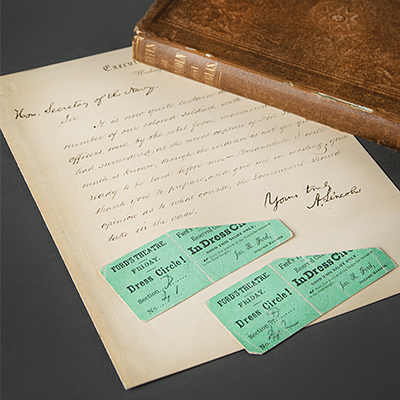Charles and Anne Lindbergh Approve John Condon as Ransom Middleman Nine Days After Kidnapping
Two ways to bid:
- Leave a max absentee bid and the platform will bid on your behalf up to your maximum bid during the live auction.
- Bid live during the auction and your bids will be submitted real-time to the auctioneer.
Bid Increments
| Price | Bid Increment |
|---|---|
| $0 | $5 |
| $50 | $10 |
| $200 | $25 |
| $500 | $50 |
About Auction
Sep 23, 2023
RR Auction support@rrauction.com
- Lot Description
Historic original ADS signed “Charles A. Lindbergh” and “Anne Lindbergh,” authorizing John F. Condon to act on their behalf during the 1932 ransom investigation of their kidnapped infant son, Charles, Jr. The handwritten note, penned in ink by Charles Lindbergh on an off-white 7.25 x 3.25 sheet, reads: “We hereby authorize Dr. John F. Condon to act as go-between for us.” The upper right is dated March 10, 1932, marking the day Condon, using the alias ‘Jafsie,’ commenced negotiations with the kidnapper. Impressively matted and framed with portraits of the Lindberghs, engraved information and biography plaques, and an original “Official Pass” to the trial of alleged kidnapper Richard Hauptmann, to an overall size of 38 x 25. In fine condition, with light creasing and intersecting folds.
Charles, Jr., the 20-month-old son of Charles and Anne Lindbergh, was kidnapped from their home near Hopewell, New Jersey, on March 1, 1932. In his stead, a ransom note demanding $50,000 was found on the windowsill of the child's nursery. Affected by the plight of the Lindberghs, John F. Condon, a well-known Bronx personality and retired school teacher, wrote an open letter to the abductors, offering his services as an intermediary. His letter was published in the Bronx Home News on March 8, 1932, and a day later, he received a letter from the kidnappers acquiescing to his request. Anxious to have their child returned, the Lindberghs hastily signed this offered document that formally authorized Condon to proceed on their behalf.
Condon, who used the newspaper codename ‘Jafsie,’ a name devised from his initials, met with kidnapper, John, twice during the ransom negotiations: first to ascertain the welfare of the child; and later to deliver the ransom money. Both meetings took place in cemeteries. During the ransom delivery meeting on April 8th, Condon was informed that the baby was safe and in the care of two innocent women. The Lindberghs’ worst fears came true when, a month later on May 12th, the corpse of a child was found in a grove of trees within five miles of their family home. Betty Gow, the Lindberghs’ family nurse identified the body as being Charles and a coroner determined the boy had been dead for about two months, the result of a blow to the head.
In September 1934, Richard Hauptmann, a carpenter and illegal immigrant from Germany, was arrested for the crime. During the now famously known ‘Trial of the Century,’ evidence quickly piled up against Hauptmann, including the discovery of ransom money in his garage, items related to the construction of a ladder used in the kidnapping, and paperwork with handwriting and spelling similar to that found on the ransom notes. Given his face-to-face contact with the kidnapper, Condon served as a key witness at the trial and his testimony was seen as crucial to the final verdict. Hauptmann was found guilty and sentenced to death in February 1935, and his execution via electric chair was carried out a year later. - Shipping Info
-
Bidder is liable for shipping and handling and providing accurate information as to shipping or delivery locations and arranging for such. RR Auction is unable to combine purchases from other auctions or affiliates into one package for shipping purposes. Lots won will be shipped in a commercially reasonable time after payment in good funds for the merchandise and the shipping fees are received or credit extended, except when third-party shipment occurs. Bidder agrees that service and handling charges related to shipping items which are not pre-paid may be charged to a credit card on file with RR Auction. Successful international Bidders shall provide written shipping instructions, including specified Customs declarations, to RR Auction for any lots to be delivered outside of the United States. NOTE: Declaration value shall be the item’(s) hammer price and RR Auction shall use the correct harmonized code for the lot. Domestic Bidders on lots designated for third-party shipment must designate the common carrier, accept risk of loss, and prepay shipping costs.
-
- Buyer's Premium



 EUR
EUR CAD
CAD AUD
AUD GBP
GBP MXN
MXN HKD
HKD CNY
CNY MYR
MYR SEK
SEK SGD
SGD CHF
CHF THB
THB














